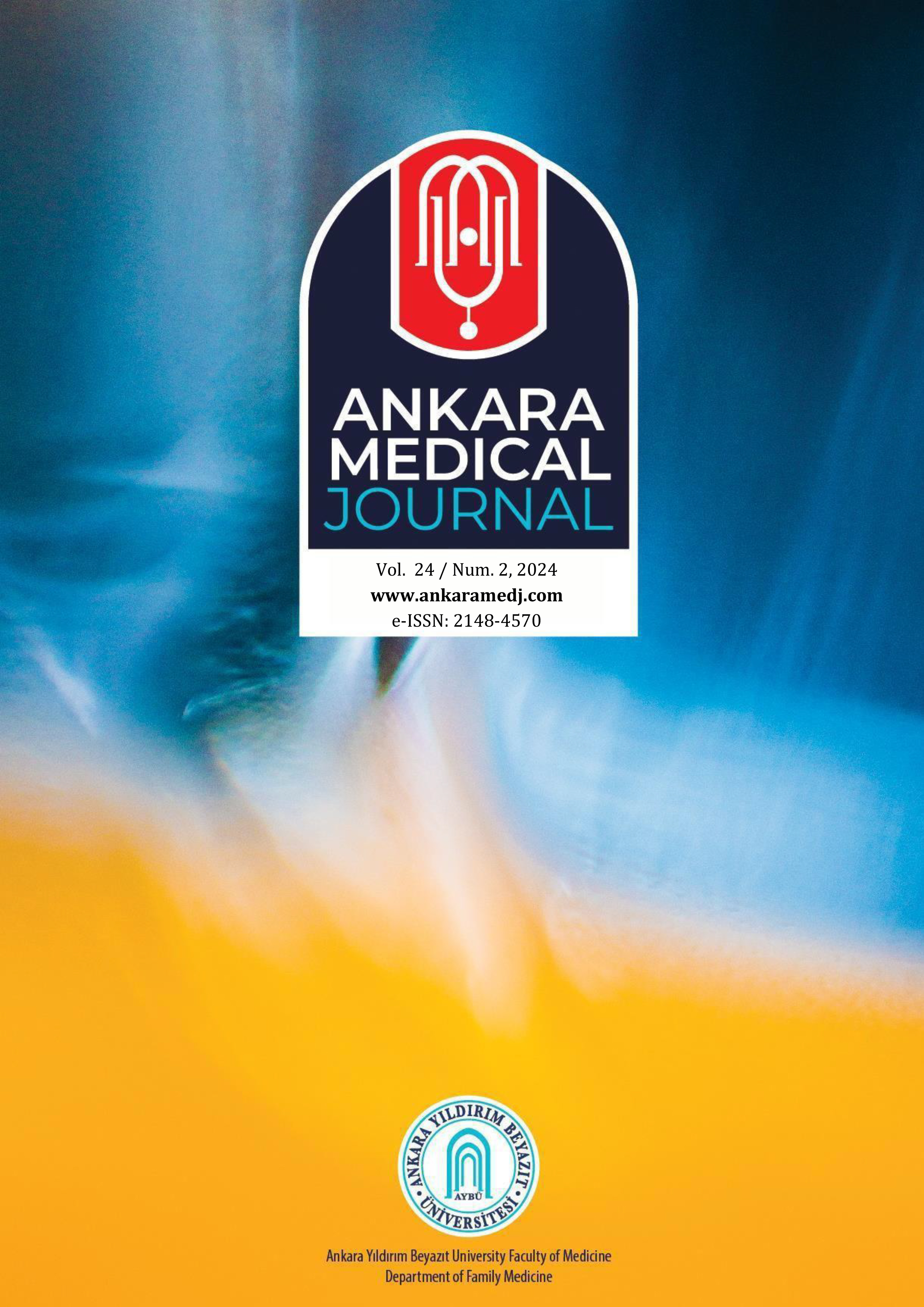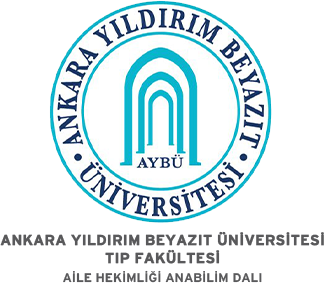E-ISSN: 2148-4570 ISSN:2148-4570
Volume: 24 Issue: 2 - 2024
| ORIGINAL ARTICLE | |
| 1. | The Relationship Between e-Health Literacy and Cyberchondria Severity with Participation in Cervical Cancer Screening İbrahim Sıddık Potur, Elcin Islek Secen, Raziye Desdicioglu doi: 10.5505/amj.2024.56323 Pages 98 - 111 INTRODUCTION: The spread of technology and the internet in society has not only been apparent in the information and communication sectors but has also affected all fields. One of the active areas where the Internet is used is in healthcare. This study aims to investigate the relationship between women's online health information-seeking behavior, e-health literacy levels, and cyberchondria severity levels with cervical cancer screening. METHODS: This research, conducted using a quantitative correlational screening model and a cross-sectional method, involved face-to-face interviews with 370 women aged 30 to 65, who applied to a gynecology clinic in Ankara City Hospital. A four-part questionnaire was used, which included women's sociodemographic data, questions aimed at understanding online health information-seeking behavior, the e-Health Literacy Scale (eHEALS), and the Short Form Version of the Cyberchondria Severity Scale (CSS-12). RESULTS: A low positive correlation was found between participants' e-health literacy and cyberchondria scale scores. However, no significant relationship was observed between online health information-seeking behavior, e-health literacy, cyberchondria severity levels, and participation in screenings. DISCUSSION AND CONCLUSION: In this study, it was observed that despite high rates of online health information-seeking behavior among women, it is not sufficient to encourage cervical cancer screenings. |
| 2. | Challenges and opportunities of online focus group discussions in refugee studies with Syrian mothers: How can we overcome the barriers? Meryem Erat Nergiz, Siddika Songül Yalçın, Suzan Yalçın doi: 10.5505/amj.2024.13911 Pages 112 - 123 INTRODUCTION: Refugee studies require extra attention due to ethical concerns and language-cultural differences. We aimed to compare the challenges and opportunities of online focus group discussions (FGDs) conducted with Syrian refugee mothers. METHODS: We used data from face-to-face and online FGDs of a study investigating the breastfeeding characteristics of Syrian mothers. FGDs were carried out with Syrian mothers and grandmothers (Group I-II), and Syrian healthcare workers (Group III) in Turkey. A total of 7 focus group discussions (FGDs) were performed face to face. 47 Syrian mothers and grandmothers and 16 Syrian HCWs attended these meetings. In two different provinces, a total of 7 FGDs were conducted online with 30 Syrian refugees, and 15 Syrian HCWs. All face-to-face FGDs were performed in Refugee Health Centres (RHCs). Online FGDs with Group I-II were performed using the technical equipment-facilities of RHCs. Group III attended the FGDs with their own devices from wherever they wanted. Thematic analysis of the transcripts in a deductive-inductive fashion was carried out with MAXQDA 11. RESULTS: Online FGDs were more favorable than face-to-face FGDs in terms of planning, selection of participants, cost, moderation, providing a heterogeneous group, equal participation, ease of recording and transcribing, privacy and anonymity, and comfort of participating. On the other hand, internet interruption and not focusing on the meeting were disadvantages of online FGDs with Group III. DISCUSSION AND CONCLUSION: Providing technological and technical support and utilizing facilitators and interpreters of the same nationality as the refugees at every stage of the study eliminated many disadvantages of online FGDs. |
| 3. | Are Diabetic Patients Aware of Their Responsibilities in Preventing Diabetic Foot Disease? Birgül Genç, Ayşegül Koç, Reyhan Ersoy doi: 10.5505/amj.2024.30771 Pages 124 - 139 INTRODUCTION: Identifying the risk factors that lead to diabetic foot disease and taking precautions is associated with a reduction in the occurrence of diabetic foot ulcers and the rate of amputation. The patient plays the most important role in that regard. This study aimed to investigate the knowledge, attitudes, and behaviors of diabetic patients, who underwent follow-up at a tertiary health center, about foot care and diabetic foot disease. METHODS: The study included 327 patients aged over 18 years, who presented to the Endocrinology and Metabolic Diseases clinic and outpatient clinic of a tertiary health center. The data were obtained using socio-demographic information and laboratory results of the subjects, information about diabetes, and responses to the diabetic foot disease awareness scale in this descriptive study. RESULTS: The patients were grouped based on diabetic foot behaviors as follows: 79 (24.15%) patients as low-score, 144 (44.03%) patients as medium-score, and 104 (31.80%) patients as high-score. There were significant differences between the groups by education and employment status, body weight, body mass index (BMI), waist circumference, type of diabetes mellitus (DM), duration (years), diabetes education, foot care education, treatment, exercise, and diabetic foot examination statuses. DISCUSSION AND CONCLUSION: Diabetic foot awareness was low in our patient group. The most important factor to increase awareness of diabetic foot disease and to prevent diabetic foot ulcers is to ensure that individuals with diabetes receive education on general diabetes and foot care and to incorporate their learnings into their behaviors. |
| 4. | Quality of Life and Digital Game Addiction in Adolescents During COVID-19 Pandemic: A Web-Based Cross-Sectional Study Raziye Çelen, Sümeyye Nur Güneş, Sibel Küçükoğlu doi: 10.5505/amj.2024.28159 Pages 140 - 152 INTRODUCTION: This study aimed to investigate the effect of digital game addiction on the health-related quality of life of adolescents. METHODS: The sample of this descriptive and cross-sectional study consisted of 300 adolescents between the ages of 10 and 14. The study was carried out in Konya, located in the center of Turkey, between February and June 2021, when there were pandemic restrictions. Participants were recruited through the snowball sampling method using an online web-based platform. Data were collected with the Personal Information Form, Digital Game Addiction Scale for Children, and KIDSCREEN-27 Health-related Quality of Life Questionnaire. RESULTS: The study revealed that the mean digital game addiction score of the adolescents was 53.32±20.84 and the majority (39.7%) were in the low-risk group for digital game addiction. A weak and moderate relationship was found between digital game addiction and the factors of the KIDSCREEN-27 Questionnaire and the time spent on digital gaming during the COVID-19 pandemic. Low psychological well-being, a bad school environment, young age, being a male, and spending higher amounts of time playing digital games during the pandemic were determined to be the predictors of digital game addiction (p<0.05). It was revealed that predictors explained 32% of digital game addiction. DISCUSSION AND CONCLUSION: It was revealed that digital game addiction affects health-related quality of life, and digital game addiction is affected by some demographic characteristics, psychological well-being, and school environment. |
| 5. | The speciality choices of future physicians A state university sample Şefik Yurdakul, Yazgı Beriy Altun Güzelderen, Egemen Unal, Salih Mollahaliloglu doi: 10.5505/amj.2024.74875 Pages 153 - 165 INTRODUCTION: Our study aims to examine the thoughts of final-year (intern) medical students about their specialty choices and the reasons underlying these thoughts. METHODS: Our study is a descriptive cross-sectional study. Intern students studying in 2022 and 2023 were asked questions about their sociodemographic characteristics and specialty choice plans. In the study, logistic regression models were created for significant variables after univariate analysis. For statistical significance, a significance level of p < 0.05 was accepted. RESULTS: The most common reason for those who did not want to specialize was the difficulty of the assistantship process, while those who wanted to specialize most commonly cited the desire to work in a specific branch that would provide professional satisfaction. It was determined that being male increases the choices for surgical sciences by 1.6 times. When socioeconomic status was examined, those with low status were found to prefer surgical sciences 4.6 times more than those with moderate status and 2.5 times more than those with high status. Choosing a surgical medical sciences increases high financial returns by 2.5 times, the desire to spend time for oneself/family by 1.8 times, the low malpractice risk in the specialty branch by 4.5 times, the difficulty of the education process by 1.8 times, and the influence of lessons/internships/instructors by 2.1 times for internal-basic medical sciences. DISCUSSION AND CONCLUSION: Improving the economic conditions of physicians, minimizing malpractice risks, and achieving work/life balance are the most important topics that need to be developed for the successful delivery of health services to the public. |
| 6. | Prediction of Addiction Potential in University Students Based On the Role of Mental Health, Self-Efficacy, and Perceived Social Support Sahar Mohammadnabizadeh, Maliheh Khalvati doi: 10.5505/amj.2024.76736 Pages 166 - 177 INTRODUCTION: One of the main areas of investigation about substance use among young people is to predict factors of an individual's vulnerability to it and recognize the variables affecting it. This study aimed to investigate of prediction of addiction potential in university students based on the role of mental health, self-efficacy, and structures of perceived social support. METHODS: In the current cross-sectional investigation 438 students of Mashhad Universities of Applied Sciences were collected using cluster sampling. The data collection tools were the Iranian version of the addiction potential scale, the general health questionnaire, the perceived social support questionnaire, and the Sherer general self-efficacy questionnaire. Data were analyzed by applying SPSS. RESULTS: The results of the linear regression analysis showed a significant relationship between addiction potential, perceived social support, self-efficacy, and mental health. Furthermore, self-efficacy was the strongest addiction potential predictor. DISCUSSION AND CONCLUSION: Based on the finding that self-efficacy is the strongest predictor of addiction potential, it is recommended to prioritize interventions and training aimed at increasing self-efficacy beliefs. By providing essential training and interventions that focus on increasing self-efficacy beliefs, we can empower young people to make healthier choices and reduce their vulnerability to addiction. |
| 7. | Does Iodinated Contrast Agent Affect Oxidative Stress? Observational Study Murat Altunok, Erdem Çankaya, Muhammet Çelik, Can Sevinc, Abdullah Uyanık doi: 10.5505/amj.2024.42385 Pages 178 - 187 INTRODUCTION: Iodine in iodine-based contrast agents (ICM) is known as an antioxidant substance from the past to the present. Although some studies suggest that the use of ICM causes contrast-induced nephropathy (CIN) by causing an increase in reactive oxygen species, this is not yet fully understood. METHODS: Before scanning and 24 hours after ICA administration, blood samples were taken from 74 patients from a single center who had no known kidney disease, had Computed Tomography using ICA, and did not develop CIN within a 5-day follow-up period. RESULTS: The mean Total Oxidant Level (TOS) before ICA was 13.72 ± 9.40 and the mean TOS after ICA was 5.20 ± 2.06 (p<0.001). The mean TAS before ICA was 2.50 ± 0.27 and the mean Total Antioxidant Level (TAS) after ICA was 2.20 ± 0.24 (p<0.001). The mean OSI before ICA was 5.36 ± 3.39 and the mean Oxidative Stress Index (OSI) after ICA was 2.39 ± 0.98 (p<0.001). DISCUSSION AND CONCLUSION: Even while the pathophysiology of CIN is attributed in part to oxidative stress, we found that, on the contrary, it caused a decrease in oxidative stress in patients who did not develop CIN. We think this decrease in oxidative stress may be due to iodine, which is contained in ICA and known as a potent antioxidant. |






